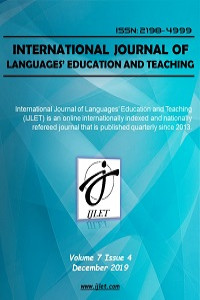Abstract
Sinema ve edebiyat birbirini etkileyen iki alan olarak kabul edilebilir. Edebiyat yapıtları, öyküleri ile sinemaya kaynak
oluştururken, özellikle modern dönem edebiyat yapıtlarının teknik bağlamında sinemadan yararlandığı görülmektedir. 1950’li
yıllarda ortaya çıkan “Yeni Roman” ekolünün şefi olarak kabul edilen Fransız yazar Alain Robbe-Grillet, romanlarında sinema
sanatı tekniğine geniş yer vermektedir. Labirentte (Dans le Labyrinthe) romanı, ikinci dünya savaşı sırasında ölen bir
arkadaşından kalma eşyaları, adresine ulaştırmaya çalışan bir askerin öyküsünü içermektedir. Asker, labirenti anımsatan
tanımadığı bir şehirde paketi ulaştıracağı adresi bir türlü bulup ulaştıramadan ölür. Roman durağan bir betimleme ve anlatım
değil, sürekli hareket halindeki bir kameranın görüntülerini içeren sahnelerle öne çıkmaktadır. Anlatıda bir dinamizm söz
konusudur. Romandaki öğelerin sunumu ve betimlenmesi aşamasında sergilenen kopukluk, sürekli geçişler ve geriye dönüşler
sinema tekniğinin romanda kullanılmasının sonucudur denilebilir. Romanın başından sonuna kadar sürekli betimleme
sahneleri tamamlanmadan birinden diğerine geçişler yaşanmaktadır. İç mekânlarla dış mekânlar veya farklı mekânlar arasında
o kadar çok anlık geçişler yaşanmakta ki hangi kesitin betimlendiğini yakalamak oldukça güçtür. Benzer özellikler nesne ve
kişilerin sunumunda da görülmektedir. Kullanılan bu kamera ve bakış açısı tekniği romanda yer alan öğeleri daha görünür
kılarken, aynı zamanda sürekli farklı karelerin yansıtılması, geçişler ve tekrarlar öykünün takibine yardımcı olmak yerine onun
anlaşılmasını daha da güçleştirmekte ve herhangi bir olayın dahi yer almadığı romanda devinimlerin akışını frenlemektedir.
Yazar, anlatma yerine gösterme tekniğini benimsemektedir. Romanda olay örgüsü bir tabloya indirgenirse, Robbe-Grillet
tabloda yer alan öğeleri bir kompozisyon bütünlüğü içerisinde vermek yerine, farklı karelerden alınmış görüntüleri sinemadaki
montaj tekniği ile ya da her seferinde kameranın farklı noktalara odaklanması şeklinde sunmaktadır.
Keywords
References
- Albérès, M. (1964). Michel Butor, classique du XXe siècle, Paris: Editions Universitaires. Barilli, R. (1964). De Sartre à Robbe-Grillet, la Revue des Lettres Modernes, no :94-99.
- Barthes, R. (1964). Littérature objective, Essais Critiques, Paris: Editions du Seuil.
- Bernal, O. (1967). Alain Robbe-Grillet: Le roman de l’absence, Paris: Galimard.
- Bloch-Michel, J. (1973). Le présent de l’indicatif, Essai sur le Nouveau Roman, Paris: Gallimard. Brooke-Rose, C. (1964). L’imagination barroque de Robbe-Grillet, Nouveau Roman? Recherches et tradition, la Revue des Lettres Modernes, 94-99.
- Rojas, C. A. et Aguilar, R.U. (2013). Qu’est-ce que le Nouveau Roman? Revista de Lenguas Modernas, 18, 169-174.
- Genette, G. (1966). Figures I, Paris : Seuil.
- Janvier, L. (1964). Une parole exigente, le nouveau roman, Paris: Les Editions de Minuit.
- Mansuy, M. (1971). Positions et oppositions sur le roman contemporain, Paris: Editions Klincksieck.
Abstract
Cinema and literature can be accepted as two domains affecting each other. While literature works and stories are the creation
resource of cinema, it is seen that the modern literature period's works especially make use of cinema in a technical way. The
French writer A. Robbe - Grillet, who was regarded as the chef of "New Novel" in 1950's, makes use of cinema techniques
widely in his novels. The novel of Labyrinth (Dans le Labyrinthe) includes the story of a soldier who wishes to deliver his dead
friend's goods to his address. The soldier dies without delivering his friend's goods in a city resembling labyrinth. The novel
doesn't include a stable description and narration, rather; it includes the mobile scenes of a camera. In the narration, there is a
instant movement. The disconnectedness, instant transitions and flashbacks presented in the flow of the story can be said to be
the results of using cinema techniques in the novel. From the beginning of the novel to the end, there is a transition of
description of scenes without completing each other. There are such variety of instant transitions in the outside places, insides
or in different places that it is very difficult to find out which scene is depicted. These similar features also seem in these
presentations of people and objects. While these camera and view techniques make the other parts of the novel vivid, it also
makes it hard to follow the story through the usage of transitions and repetitions instead of making it easy. The writer adopts
show technique rather than narrative technique. If the flow of storylines in the novel boils down to a picture, Robbe - Grillet
presents the storylines either in a assembly technique using the different scenes or giving storylines focusing on its different
place in each shoot instead of giving the parts of the picture a compositional coherence.
Keywords
References
- Albérès, M. (1964). Michel Butor, classique du XXe siècle, Paris: Editions Universitaires. Barilli, R. (1964). De Sartre à Robbe-Grillet, la Revue des Lettres Modernes, no :94-99.
- Barthes, R. (1964). Littérature objective, Essais Critiques, Paris: Editions du Seuil.
- Bernal, O. (1967). Alain Robbe-Grillet: Le roman de l’absence, Paris: Galimard.
- Bloch-Michel, J. (1973). Le présent de l’indicatif, Essai sur le Nouveau Roman, Paris: Gallimard. Brooke-Rose, C. (1964). L’imagination barroque de Robbe-Grillet, Nouveau Roman? Recherches et tradition, la Revue des Lettres Modernes, 94-99.
- Rojas, C. A. et Aguilar, R.U. (2013). Qu’est-ce que le Nouveau Roman? Revista de Lenguas Modernas, 18, 169-174.
- Genette, G. (1966). Figures I, Paris : Seuil.
- Janvier, L. (1964). Une parole exigente, le nouveau roman, Paris: Les Editions de Minuit.
- Mansuy, M. (1971). Positions et oppositions sur le roman contemporain, Paris: Editions Klincksieck.
Details
| Primary Language | Turkish |
|---|---|
| Subjects | Turkish Language and Literature (Other) |
| Journal Section | Research Article |
| Authors | |
| Publication Date | December 30, 2019 |
| Published in Issue | Year 2019 Volume: 7 Issue: 4 |


